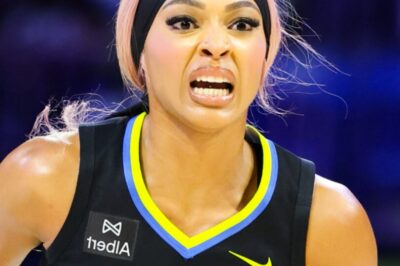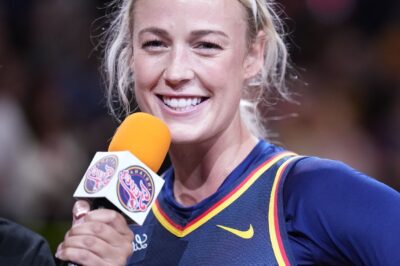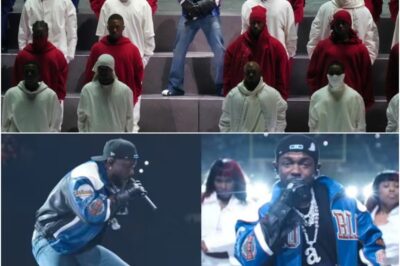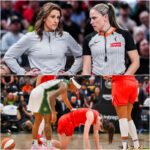It was supposed to be just another electrifying night in the WNBA, another chance for Caitlin Clark to dazzle a packed arena and a national TV audience with her signature blend of swagger, vision, and pure scoring magic. Instead, it became the night everything changed—not just for Clark, not just for the Indiana Fever, but for the entire league. Every detail of that fateful third quarter between the Fever and the Liberty has been picked apart by fans, pundits, and former players, but nothing can quite capture the shock of the moment Clark hit the hardwood and the whole arena seemed to stop breathing.
Clark had already racked up 15 points, weaving through defenders with the kind of confidence that’s made her a household name and the face of a new generation of women’s basketball. The Fever, underdogs as always, were holding their own against the Liberty’s star-studded roster. Then, with the game hanging in the balance, Clark took the ball across half-court, locked eyes with the defense, and darted toward the lane. Sabrina Ionescu, a star in her own right, stepped up to challenge her. In the blink of an eye, the two collided—Clark’s knee twisted at an unnatural angle, and she crumpled to the floor.
The sound in the arena shifted instantly from fever-pitch excitement to a stunned, hollow silence. Clark didn’t pop up the way she usually does, didn’t brush herself off and jog back on defense. She stayed down, clutching her knee, her face twisted in pain. Teammates hurried to her side, some too shocked to speak, others visibly furious. The Liberty players stood frozen, Ionescu herself looking shaken by what had just happened.
The officials gathered, glanced at a replay, and then—almost unbelievably—let play resume. No foul, no flagrant, not even a warning. The game went on as if nothing had happened, but the mood in the building was icy, the crowd restless and angry. The Liberty won, but nobody was talking about the final score.
What happened next was a masterclass in how quickly the narrative can spin out of a league’s control. Hours after the game, a courtside video began making the rounds on social media, shot from a fan’s phone at just the right angle to capture every detail of the collision. This wasn’t a blurry, ambiguous clip; it was crystal clear. It showed Ionescu stepping into Clark’s path, making forceful contact with her lead leg. Clark’s knee buckled, her body twisted, and the pain was obvious. It wasn’t a flop. It wasn’t incidental contact. It was a dangerous, high-risk play—and the refs hadn’t even blown the whistle.
The outrage was instant and overwhelming. By morning, #JusticeForClark was trending, ESPN anchors were debating the play on air, and NBA stars were weighing in with their own takes. The WNBA finally released a statement, but it was too little, too late. “The safety of our players is our top priority. We are conducting a full review,” the league said, but by then, the damage was done.
It didn’t help that news soon leaked—through unofficial channels, not from the league itself—that one of the referees from that night had been quietly suspended pending an internal investigation. The secrecy only fueled the anger. Was this a cover-up? Was the league protecting its officials at the expense of its players? Or, even worse, was the league protecting its own image and marketable stars at the expense of fairness and safety?
Players didn’t hold back. A’ja Wilson, Clark’s teammate and reigning MVP, tweeted, “That wasn’t just ‘physical play.’ That was dangerous. We have a right to protection, just like anyone else.” Brittney Griner chimed in, “You can’t talk about growing the league while letting stars get hurt like this.” Even veterans like Sue Bird and Diana Taurasi, who rarely wade into officiating controversies, spoke out. “We’ve all had hard falls,” Taurasi said, “but you know when the whistle doesn’t blow because someone’s scared to call it? That’s when it’s a problem.”
Sabrina Ionescu, now at the center of a media firestorm, eventually addressed reporters. “I didn’t mean to hurt anyone,” she said. “It was a heat-of-the-moment play. I’m not a dirty player. But I understand the criticism. I wish Caitlin a full and fast recovery.” Her words were measured, but the damage was done. The conversation had moved beyond whether the play was dirty. Now, it was about whether the league itself was complicit in putting its brightest stars at risk.
A few days later, the WNBA confirmed the official’s suspension and promised a full, independent review—not just of the play, but of how the league handles officiating, player safety, and internal accountability. The language was strikingly serious: “In light of the seriousness of the allegations and the league’s commitment to fairness, the WNBA is placing the official in question on administrative leave. We will be working with a third-party panel to assess officiating standards and processes moving forward.” Behind the scenes, sources whispered that the review would look at whether certain players or teams were getting more lenient treatment from refs, especially during nationally televised games.
The incident sparked a wave of investigative reporting. The Athletic and ESPN both published stories alleging inconsistencies in officiating, underreporting of player complaints, and even pressure from league executives not to “overpenalize” stars during big games. Some referees, speaking anonymously, admitted they felt caught between letting the league’s young stars shine and enforcing the rules. “You can’t have it both ways,” one said. The implication was clear: the rules weren’t being applied evenly, and the league’s desire for marketable superstars was creating a dangerous gray area.
Meanwhile, Clark’s injury—eventually diagnosed as a moderate knee sprain—wasn’t season-ending, but it was enough to sideline her for weeks. When she finally spoke to the press, her message was clear and calm: “I’m thankful it wasn’t worse. I’m focused on recovery. I love this game, and I want it to be safe—for everyone.” Her words resonated far beyond Indiana. They were a reminder that, for all the money and attention now pouring into women’s basketball, the players themselves are still vulnerable.
Without Clark, the Fever struggled. Their offense sputtered, their playoff hopes dimmed, and morale took a hit. But something else happened, too: fans kept showing up. Teammates stepped up. Clark, even from the bench, was a constant presence—encouraging, strategizing, refusing to let her team’s spirit break. The crowd noticed. So did the rest of the league.
This was more than just a basketball story. It was a moment of reckoning for a league in the midst of explosive growth. The WNBA has never been more popular—record TV ratings, sold-out arenas, global stars. But with that growth comes scrutiny, and with scrutiny comes the need for real transparency and accountability. If the league wants to be taken seriously, it can’t just rely on talent and highlight reels. It needs to earn the trust of its players, its fans, and the wider sports world.
The fallout from the Clark incident is still unfolding. The independent investigation is ongoing. The suspended referee’s fate is undecided. Clark is back in light workouts, but a full return will take time. Meanwhile, the league has promised a slate of reforms: enhanced referee training, expanded use of video review, a new Player Safety Committee, and a public tracker for controversial officiating moments. Whether those changes are enough remains to be seen.
But one thing is certain: that night changed everything. Not just because Caitlin Clark got hurt—injuries happen in sports—but because when she did, the system that was supposed to protect her failed. And everyone saw it. Fans, players, coaches, and the world. Now, the WNBA has a choice: learn from this, or risk letting it happen again. If there’s one thing Clark’s meteoric rise has shown us, it’s that people are watching. They care. And after that night, the league will never be quite the same.
News
“This Changes EVERYTHING!” Prosecutors Make Shocking Final Decision on D3ath S3ntence for Karmelo Anthony and No One Saw It Coming
Karmelo Anthony (Photo via Google) The story of Karmelo Anthony, a Texas teenager now thrust into the national spotlight,…
Everybody Said The Same Thing About WNBA Star DiJonai Carrington’s Private Piercings That Were Clearly Visible During Game
DiJonai Carrington (Photo via Twitter) DiJonai Carrington just got a whole new fan base after her latest outfit. Paige Bueckers…
Sophie Cunningham Drops Sh0cking Truth About WNBA and Indiana Fever That Has Everyone Talking
Things have been rough for the Indiana Fever lately. After going above .500 following their win over the Connecticut Sun…
BREAKING: Super Bowl Halftime Show Performer Arrested And Now Facing Lifetime NFL Ban
Kendrick Lamar performs during the halftime show of Super Bowl LIX between the Philadelphia Eagles and the Kansas City Chiefs…
VIDEO: American Sprinter Chris Robinson’s Junk Fell Out Of His Pants In The Middle Of A Race, And He Still Won While Giving Everyone A Free Show
American hurdler Chris Robinson (Photo via YouTube) American hurdler Chris Robinson was competing in the Ostrava Golden Spike meet…
VIDEO: MLB Commentator Can’t Hide His Excitement After Camera Pans To Woman Wearing A Th0ng On Live TV During Cubs-Cardinals Game
Cubs-Cardinals camera shot (Photo via Stream Cubs) A clip from Thursday’s Cubs-Cardinals game is going viral as it shows cameras…
End of content
No more pages to load













